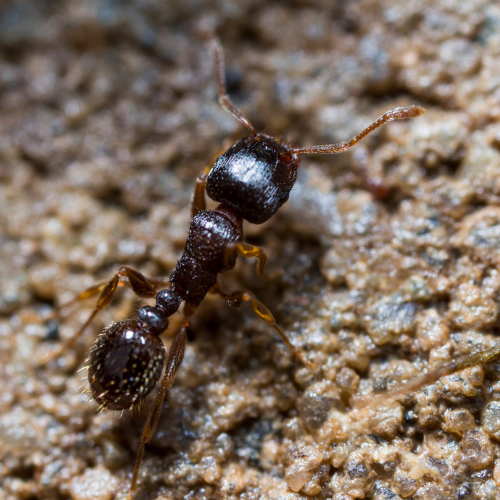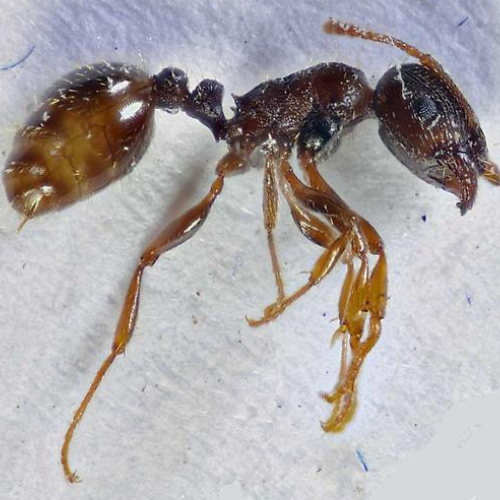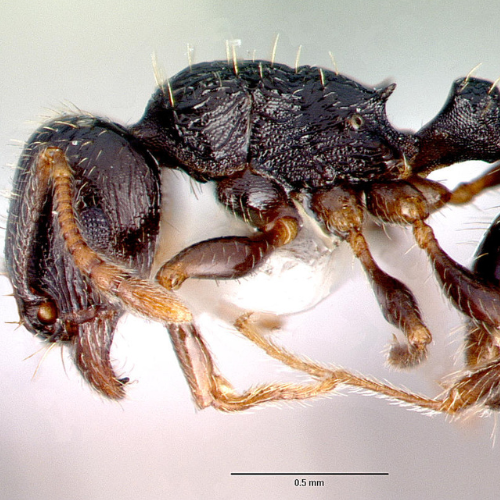Pavement Ant
Introduction to
Pavement ants, scientifically known as Tetramorium caespitum, are a common sight in urban environments. These small, dark brown to black ants are aptly named for their tendency to nest under pavement and building foundations. Known for their aggressive nature and competitive interactions with other ant species, pavement ants can become a nuisance when they invade homes in search of food. Understanding their biology, habits, and effective prevention strategies is crucial for managing their presence and maintaining a pest-free environment.
Recognition
Pavement ants are small, typically measuring about 1/8 inch in length. They are dark brown to black in color and have distinct grooves on their head and thorax. A key identifying feature is the presence of two spines on the back portion of their thorax and a petiole with two nodes. Unlike other ants, pavement ants have a pair of backward-projecting spines on the thorax and distinctly visible antennae with 12 segments, ending in a three-segmented club. They are often observed creating small mounds of displaced soil along sidewalks, driveways, and building foundations.
Biology
Pavement ants undergo complete metamorphosis, progressing through egg, larva, pupa, and adult stages. The queen lays eggs, which hatch into larvae. These larvae are nurtured by worker ants until they pupate and eventually emerge as adults. A typical pavement ant colony consists of a single queen, numerous workers, and reproductive males and females. Colonies can grow large, housing several thousand individuals. Pavement ants are known for their aggressive behavior, often engaging in battles with neighboring colonies to defend their territory and expand their range.
Habits
Pavement ants prefer to nest in and around urban areas, typically under sidewalks, driveways, and building foundations. They also nest in soil, under rocks, and within wall voids or insulation in homes. These ants are omnivorous, feeding on a variety of substances including insects, seeds, sweets, and greasy foods. Pavement ants forage in long trails and are often seen invading kitchens and pantries in search of food. They are most active during the warmer months, but indoor infestations can persist year-round, especially in heated buildings.
Prevention
Preventing pavement ants from invading homes involves a combination of exclusion and sanitation measures. Seal cracks and crevices around the foundation, windows, and doors to block entry points. Store food in airtight containers and clean up spills and crumbs promptly. Outdoor maintenance is also crucial; trim vegetation away from the house and remove potential nesting sites such as stones, wood piles, and debris. Regularly inspect and maintain the perimeter of the home to ensure ants do not establish colonies near the structure. Proper waste management and sanitation practices can significantly reduce the risk of ant infestations.
Professional
If pavement ants become a persistent problem, professional pest control services can provide effective solutions. STL Pest Control offers comprehensive treatments, including baiting and barrier sprays, to eliminate ant colonies and prevent reinfestation. Their technicians are trained to identify the specific species and tailor treatments accordingly. In severe cases, they may recommend ongoing maintenance plans to keep the environment ant-free. Relying on professional services ensures a thorough and long-lasting resolution to ant infestations, providing peace of mind and a healthier living space.



Our Office









